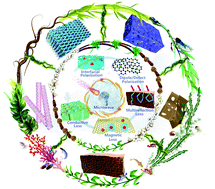3D porous biomass-derived carbon materials: biomass sources, controllable transformation and microwave absorption application
Abstract
Nowadays, to prevent acute electromagnetic pollution and develop efficient stealth materials, enormous efforts have been taken in pursuit of high-performance microwave absorption (MA) materials. Compared to classical microwave absorbers, biomass-derived porous materials, including natural materials and recyclable materials, have attracted great attention for their extensive sources, cheap cost, low density and reusability. To date, many works have indicated that biomass-based absorbers from different raw materials exhibit excellent MA performance. Herein, various sources of biomass materials that can be utilized for MA are discussed and several common reduction approaches for those materials are analyzed. Additionally, it is significant to understand how to obtain an optimum MA capacity by adjusting relative factors, so reduction conditions are also expounded on. Besides, different morphologies of biomass materials and the relationship between structure and properties are discussed. Finally, we comprehensively summarize biomass-based MA composites with different types of attenuation modes and mechanisms to explain the principal problems and push the development of biomass-based porous MA materials forward.

- This article is part of the themed collection: Green Chemistry Reviews


 Please wait while we load your content...
Please wait while we load your content...